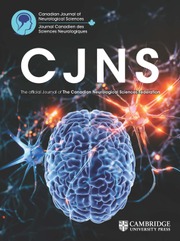No CrossRef data available.
Article contents
Friedreich's Ataxia: Observations with Q and G Banding of Human Chromosomes
Published online by Cambridge University Press: 18 September 2015
Summary:
Core share and HTML view are not available for this content. However, as you have access to this content, a full PDF is available via the ‘Save PDF’ action button.
No chromosomal anomaly was found in 15 cases of typical Friedreich’s ataxia and three cases of atypical recessive ataxia studied with Q and G banding techniques. No difference between frequency of chromosomes gaps or breakages was noted amongst patients with Friedreich’s ataxia and controls.
- Type
- Quebec Cooperative Study of Friedreich's Ataxia
- Information
- Copyright
- Copyright © Canadian Neurological Sciences Federation 1976
References
REFERENCES
Battaglia, E., Guanti, G., BArsanti, P., and Petrinelli, P. (1971). Chromosomal survey in 298 normal subjects and 1,253 cases of congenital disorders during 1966–1970. Acta Genet. Med. (Roma), 20, 123–173.CrossRefGoogle Scholar
Bell, J., and Carmichael, E.A. (1939). On hereditary ataxia and spastic paraplegia. In: Treasury of Human Inheritance, Vol. 4, Cambridge University Press, (Fisher, R.A., éd.), pp. 141–281.Google Scholar
Caspersson, T., Zech, L., Johansson, C, and Modest, E.J. (1970). Identification of human chromosomes by DNA-binding fluorescent agents. Chromosoma (Beri.), 30, 215–227.Google ScholarPubMed
Lubozynski, M.F., and Roelofs, R.I. (1975). Friedreich’s ataxia. Sth. Med. J., 68, 757–763.CrossRefGoogle ScholarPubMed
Samad, F.U., Engel, E., and Hastmana, R.C. (1973). Hypoplastic anemia, Friedreich’s ataxia and chromosomal breakage. Case report and review of similar disorders. Sth. Med. J., 66, 135–140.Google ScholarPubMed
Skre, H. (1975). Friedreich’s ataxia in Western Norway. Clin. Genet., 7 (4), 287–298.CrossRefGoogle ScholarPubMed


